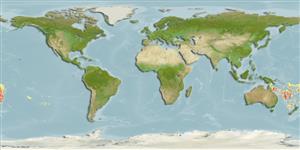Klassifizierung / Names
Namen | Synonyme | Catalog of Fishes(Gattung, Arten) | ITIS | CoL | WoRMS | Cloffa
Elasmobranchii (Haie und Rochen) (sharks and rays) >
Carcharhiniformes (Ground sharks) >
Pentanchidae (Deepwater catsharks)
Etymology: Apristurus: a-, Latin privative, i.e., without; pristis, from pristes (Gr.), sawyer (but here meaning saw); oura (Gr.), tail, referring to absence of saw-toothed crest of enlarged dermal denticles along upper edge of caudal fin as found in the closely related Pristiurus (=Galeus). (See ETYFish); albisoma: albus (L.), white; soma (Gr.), body, referring to its whitish color. (See ETYFish).
Environment: milieu / climate zone / depth range / distribution range
Ökologie
seewasser bathydemersal; tiefenbereich 935 - 1564 m (Ref. 36058). Deep-water
Western Pacific: southern waters off New Caledonia, slopes of the seamounts of the Norfolk and Lord Howe ridges.
Size / Gewicht / Alter
Maturity: Lm ? range ? - ? cm
Max length : 59.6 cm TL Männchen/unbestimmt; (Ref. 36058); 56.6 cm TL (female)
Kurzbeschreibung
Morphologie | Morphometrie
Body whitish. Eyes small; interobital region 2.7 - 3.6 times eye diameter. Supraorbital sensory canal continuous. Second dorsal fin axil before anal fin axil. Upper labial furrows equal or shorter than lower furrows. Tricuspid dermal denticles overlapping. Spiral valves 6-10.
Sexual maturity attained between 40 and 50 cm TL (Ref. 36058). Oviparous (Ref. 50449).
Life cycle and mating behavior
Geschlechtsreife | Fortpflanzung | Ablaichen | Eier | Fecundity | Larven
Oviparous, paired eggs are laid. Embryos feed solely on yolk (Ref. 50449).
Nakaya, K. and B. Séret, 1999. A new species of deepwater catshark, Apristurus albisoma n.sp. from New Caledonia (Chondrichthyes: Carcharhiniformes: Scyliorhinidae). Cybium 23(3):297-310. (Ref. 36058)
IUCN Rote Liste Status (Ref. 130435)
Bedrohung für Menschen
Harmless
Nutzung durch Menschen
Mehr Information
Alter/GrößeWachstumLänge-GewichtLänge-LängeLängenhäufigkeitenMorphometrieMorphologieLarvenLarven Pop.Dyn.RekrutierungDichteBRUVS
ReferenzenAquakulturAquakultur ProfilZuchtlinienGenetikElectrophoresesVererbbarkeitKrankheitenVerarbeitungNutrientsMass conversion
PartnerBilderStamps, Coins Misc.LauteCiguateraGeschwindigkeitSchwimmstilKiemenoberflächeOtolithsGehirngrößeSehfähigkeit
Tools
Zusatzinformationen
Download XML
Internet Quellen
Estimates based on models
Preferred temperature (Ref.
123201): 3 - 4.5, mean 3.9 °C (based on 108 cells).
Phylogenetic diversity index (Ref.
82804): PD
50 = 0.5000 [Uniqueness, from 0.5 = low to 2.0 = high].
Bayesian length-weight: a=0.00355 (0.00176 - 0.00714), b=3.09 (2.91 - 3.27), in cm total length, based on LWR estimates for this (Sub)family-body shape (Ref.
93245).
Trophic level (Ref.
69278): 3.9 ±0.4 se; based on size and trophs of closest relatives
Widerstandsfähigkeit (Ref.
120179): sehr niedrig, Verdopplung der Population dauert mehr als 14 Jahre. (Fec assumed to be <10).
Fishing Vulnerability (Ref.
59153): Moderate vulnerability (44 of 100).
